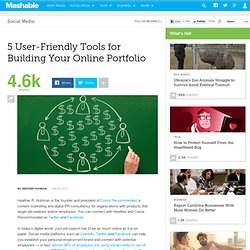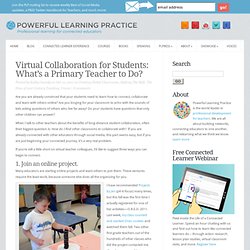

5 User-Friendly Tools for Building Your Online Portfolio. Heather R.

Huhman is the founder and president of Come Recommended, a content marketing and digital PR consultancy for organizations with products that target job seekers and/or employers. You can connect with Heather and Come Recommended on Twitter and Facebook. In today’s digital world, your job search has to be as much online as it is on paper. Social media platforms such as LinkedIn, Twitter and Facebook can help you establish your personal employment brand and connect with potential employers — in fact, almost 90% of employers are using social media to recruit potential employees [PDF]. What better way to have all of your online and offline job search tools in one place than in a portfolio? An online portfolio allows you to compile what makes you employable — it should include things like your resume, cover letter, references, certifications, transcripts and any examples of your work (including writing samples, press clips, artwork or lesson plans). 1. 2. 3.
Cost: Free 4. 5. Jimmy Wales on Collaboration. Collaborative Learning in Social Networks. IntroductionI am here in Anguilla reflecting on a number of ‘Social Media and Academic practice’ sessions that I co-presented with Andy Coverdale from the University of Nottingham.

As PhD researchers at the School of Education, we felt comfortable enough to extend our knowledge and experience in what we saw as a gap in the doctoral training programme. What we found was that most participants use social media tools like Facebook, but did not see the need or connection of using these social media tools1 as part of their academic researcher identity. These sessions afforded us the opportunity to address transferable skills that could provide the context for academic researchers to develop and maintain their digital academic identity within the online digital landscape. We held these sessions at the Jubilee Graduate Centre, the Arts and Engineering graduate centre and recently presented an overview of what we have been doing at the e-learning conference at the University of Greenwich.
Collective intelligence 2.0. Virtual Collaboration for Students: What’s a Primary Teacher to Do? Are you are already convinced that your students need to learn how to connect, collaborate and learn with others online?

Are you longing for your classroom to echo with the sounds of kids asking questions of others who live far away? Do your students have questions that only other children can answer? When I talk to other teachers about the benefits of long-distance student collaboration, often their biggest question is: How do I find other classrooms to collaborate with? If you are already connected with other educators through social media, this part seems easy, but if you are just beginning your connected journey, it’s a very real problem. If you’re still a little short on virtual teacher colleagues, I’d like to suggest three ways you can begin to connect. 1. Many educators are starting online projects and want others to join them.
Thousands of other students stacked Oreos along with us. 2. Using Skype to Connect and Learn Skype now has an education site. 3. RessourcesPedagogigues. Introduction_reseaux_sociaux_v_1.pdf (Objet application/pdf)
6 Tips for Open Collaboration. Share, Converse and Connect. Share, Converse and Connect.